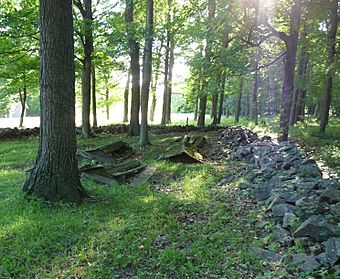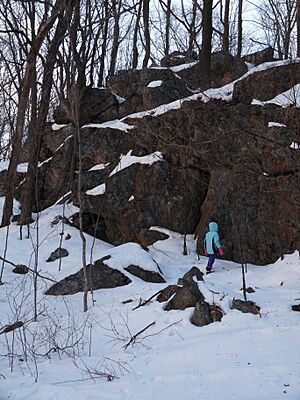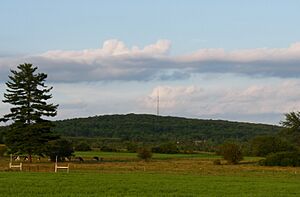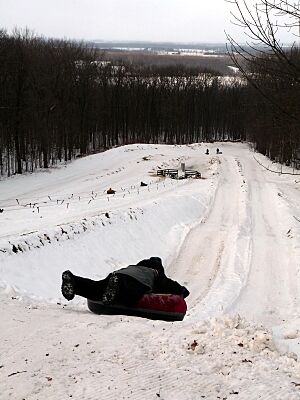Powers Bluff facts for kids
Quick facts for kids |
|
|
Powers Bluff
|
|
 |
|
| Location | Arpin, Wisconsin |
|---|---|
| NRHP reference No. | 02000732 |
| Added to NRHP | July 5, 2002 |
Powers Bluff is a wooded hill in central Wisconsin, close to Arpin. For many years, American Indians lived here. They called the hill Tah-qua-kik, which means Skunk Hill. Because of its important religious and cultural history, Tah-qua-kik is listed on the National Register of Historic Places.
Today, part of the hill is a fun place called Powers Bluff County Park. In winter, it's famous for its inner-tube hill, where people slide down on tubes. At 1,472 feet above sea level, Powers Bluff is the highest point in Wood County.
Contents
The Amazing Geology of Powers Bluff
Powers Bluff has some amazing rock formations. These stone outcrops stick out from the top of the hill. Some of them are as tall as a two-story building! The bluff is made of a very hard rock called quartzite. The very top also has a rock called chert.
Scientists believe this quartzite is incredibly old, about 1.6 billion years old. That's much older than the Himalayas mountains! This pink quartzite is a very hard, semi-precious stone. Over millions of years, softer rocks around it wore away, leaving the strong bluff standing tall.
You can find small pieces of the unusual chert rock from Powers Bluff spread out to the southeast for about 20 kilometers. This shows that a huge sheet of ice, called a glacier, once moved over the bluff. It broke off pieces of rock and carried them far away.
Plants and Animals at Powers Bluff
Most of Powers Bluff is covered by a thick forest. Many of the trees are very old and large sugar maples. These trees are beautiful, especially in the fall when their leaves turn bright red and yellow.
In spring, around mid-April, the forest floor comes alive with wildflowers. You can see mayflowers, Dutchman's breeches, spring beauties, and trout lilies. Later in the summer, ferns and blue cohosh grow in the shade. A tiny fern called goblin moonwort, which is very rare in Wisconsin, also lives here.
Many animals call Powers Bluff home. You can often spot gray squirrels, chipmunks, and white-tailed deer roaming around.
Human History at Powers Bluff
East of the bluff, there are five large mounds made by people. They are about two to three feet high and 25 to 30 feet wide. These mounds show that American Indians visited Powers Bluff long ago, even before written records. We don't know exactly who built them.
The Tah-qua-kik Community
In the late 1800s, a group of Potawatomi people settled at Powers Bluff. They were led by a spiritual leader named John Young. They called their village Tah-qua-kik. These Potawatomi people had been forced to move many times by the U.S. government. Some had been sent to reservations far away, but they found their way back to Wisconsin.
Tah-qua-kik was not a government-run reservation. This meant the people living there could keep their traditions and culture strong. The bluff was a quiet, hidden place back then, surrounded by forest.
Around 1871, a railroad line was built seven miles north of the bluff. John Young and his group likely moved on after a short time. They went to other places in Wisconsin, like Indian Farms near Rozellville.
Life in the Village
In the 1890s, a company cut down the trees on the bluff. After the logging stopped in 1904, more Potawatomi people came back to Powers Bluff. In 1905 or 1906, a local newspaper described their homes:
Their houses were made of poles and branches, covered with large pieces of bark. Inside, there was a platform about 30 inches high and seven to eight feet wide. This was used for sitting during the day and sleeping at night. In the middle of the house, they had a fire to cook meals on rainy days. They also hung different kinds of roots from the roof.
The main part of the community was at the top of the bluff, on the warm south side of the rock outcrops. Other homes were spread out on the south slope below. The Medicine Society had a special longhouse covered in canvas. There was also a building just for drums.
Other Native American groups also lived at Tah-qua-kik, including some Chippewa, Ho-Chunk, Kickapoo, and later Menominee people. In 1910, about 100 Native Americans lived in 21 homes in the area. They were led by a Ho-Chunk man named White Pigeon and a Potawatomi man named John Nuwi.
The people supported themselves in many ways. In spring, they made maple sugar to use and trade. Throughout the year, they hunted, gathered plants, gardened, trapped animals, worked on local farms, and sold crafts.
Ceremonies and Dances
The community held important dances several times a year. These dances attracted hundreds of visitors from all over Wisconsin and even as far as Kansas. Some visitors came by train to Arpin. People from other tribes and even non-Native neighbors joined in. The ceremonies lasted for several days, with traditional costumes, drumming, dancing, and speeches.
There was a thanksgiving dance in May, another religious or thanksgiving dance in July, and a harvest dance in late summer or early fall. The Medicine Lodge dance was held at different times throughout the year.
Over time, some homes at Tah-qua-kik started to look more like those in nearby towns, with log cabins and frame houses. Some families began using iron stoves and kerosene lamps. But the number of people living there slowly went down. By 1930, the main village at the top of the hill was no longer used.
In 1936, the town of Arpin gave the land at the top of the bluff to Wood County. The county then turned it into a park. The ski runs on the north side of the bluff opened in 1948, and a warming house was built in 1950.
In 1999, the county wanted to make the ski hill bigger. However, Native Americans were concerned because it would mean cutting down trees that marked graves and disturbing burial sites. In 2003, they reached an agreement, and not much has changed since then.
Powers Bluff County Park Today
Powers Bluff County Park was created in 1936. In winter, it's a popular spot for inner-tubing and downhill skiing. There are lifts to take you up the hill and a warming house, open on weekends. You can also go cross-country skiing during the week.
In other seasons, the park has a picnic area, a playground, and hiking trails. Signs in the park explain the geology of the bluff and its Native American history. You can still see two ceremonial dance rings in the picnic area. Two Native American cemeteries are also protected by fences made of boulders.
East of the park, there's a 70-acre area called Powers Bluff Maple Woods. It's a state Natural Area, meaning it's protected for its natural beauty.
While the park covers the top of the bluff, some parts of Powers Bluff outside the park are privately owned. These areas are used for homes and farming.
Images for kids





